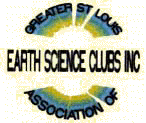|






| |
Rockwood Rockhound News
October 2002

Our new member, Ken Vaisvil will be telling us all about geodes on the Friday, Oct. 18th meeting and then leading us on a field trip on October 19th. We will meet at Daniel Boone Library at 7:30 am and return about 5:30 pm. We will be looking for geodes in fields, streams and road cuts in the Keokuk area. Bring a lunch, collecting bucket and appropriate tools. Wear old clothes!
The fall colors should be around their peak that week-end so this might be a nice way to get outdoors and relax.

Comments, Etc.
The Internet is a wonderful thing and has definitely made the world a smaller place. Eight years ago your editor, Claudia Uccello, began to correspond with a young man in England, Sean McMahon. He was six at the time and wanted to talk to someone about
fossils. We corresponded for eight years and met over in England a couple of times. Sean kept up his interest in fossils and has become quite an expert. For the past several years he has been involved in a group called the Sedgwick Young Design Squad. This young
group was given the task of helping to renovate the Palaeozoic Wing at the Sedgwick Museum of Geology at Cambridge. University. This museum was first opened in 1904 and was arranged in Victorian Style. Sean’s group was invited to help make the museum more interesting . After several years of hard work, the museum had a grand reopening on September 20th. Sir David Attenborough, author of the “Blue Planet” series and Dr. David Norman, a famous dinosaur palaeontologist were the key note speakers. Thanks to Sean, your editor was able to be there for that momentous occasion! This experience of a lifetime was possible because of the internet. The museum
has a web site: http://www.sedgwickmuseum.org
Check it out!

Roy Cottrell is recovering from a broken jaw. He has just had the braces removed. However, he lost 30 pounds while he was wired. We will let Roy tell you how he broke his jaw in the first place.
From Our
Secretary 
Minutes of the September 20, 2002 Meeting of the
Rockwood Gem and Mineral SocietyThe meeting was called to order at 7:00 p.m. by president Joan Schlichter.
Hospitality chairperson Helen Heitland reported that there were 14 members present and no guests.
Secretary Marianne Toenjes reported that there were no minutes from the last meeting which took place at the annual club picnic.
Coordinator Dianne Larson reported that a club exhibit will be placed at the Grand Glaize Library in November. She also asked Claudia about
keeping libraries well stocked with flyers about the club.
Editor Claudia Uccello reported she had no details yet on the Springfield, Illinois field trip. Dianne then mentioned that the trip to the Midwest Show is Saturday, October 5 and the club will pay entrance fees. Those wishing to attend should sign up and meet at the Daniel Boone Library at 10 a.m. that day.
Education chairperson asked how far in advance permission must be gotten for a library display. Dianne said to ask well ahead and that a new library will open in January in Chesterfield--the Stephen Sachs Library. Dianne will inquire about a future exhibit there.
Vice President Peggy Nuske said she is waiting to hear from Mary Parrott about when Mike Fuller will speak to the club. Mary's new phone number is 636-337-0862.
There was no report from the historian, Matt Bannon as he is on a Boy Scout trip.
Field Trip chairperson Andy Larson reported on the Midwest Federation show at Queeny Park on August 16-18. Attendance was 1551 with a profit of $4,000. Our club received 28% of the profit last year and will probably get about the same amount this year.
Member Ken Vasily spoke about experiences at Scheffler's and a place nearby in Hamilton where lots of castoff geodes are available for $15 a bucket.
Telephone committee chairperson Joyce Erard had no report.
Joan asked for volunteers to serve on the nominating committee. Dianne Larson, Hank Schlichter and Eleanor Stuut volunteered. The election of new officers will take place in November.
Dianne asked if Bob Morse had purchased a TV and VCR for the club but since Bob was not present it is unknown.
A slide program that was submitted a while ago to the Midwest Federation will be shown after the meeting by the
Schlichters.
The meeting adjourned at 7:30 p.m.
Hank Schlichter then spoke about Washington County minerals and showed the slides about these minerals and where to find them.
Submitted by Marianne Toenjes, Secretary

News from Other Clubs
Strange Mineral Tales
A long time a ago if you wanted a candle, you went to a beekeeper. His wax and your wick made a candle. In modern times candles are mass produced from paraffin which is a commercially refined product of petroleum. What is not widely known is that wax can also be mined! There are very few places where wax has been mined on a commercial basis because of the quantities available . A location in Austria was the only place where wax was being mined in this century until a discovery was made at Soldier Summit, Utah.
The wax is related to petroleum and is called ozokerite. It is apparently a high quality form of natural paraffin, developed from the residue of crude oil percolating through fissures in rocks. Compared to beeswax and man-made paraffin, its melting point is much greater (between 155 and 190 degrees.)
Ozokerite was sometimes found in large veins that were almost 100% pure. The majority, however, is found in a brecciated form bound up with sandstone and shale. Once mined, it must be crushed, then dumped into tanks of boiling water where the wax is skimmed and poured into molds. The “wax belt” of ozokerite covers an area of about 12 miles in Utah. Large tailing piles from the mining operation of the American Ozokerite Co. are strewn alongside U.S. 50 near Soldier Summit. (Via The Glacial Drifter)
How Does a Bone Become a Fossil?
For every bone that becomes a fossil, millions do not. It takes many thousands of years and very special conditions for a fossil to form. Fossils are the remains of ancient life. Fossils can be found poking out of the earth in the Badlands of South Dakota. To become fossils, bones are first buried. Usually, this happens when an animal dies by a river, stream or ocean. In such a place, water often washes sand, mud and other fine-grained materials over the body. The soft tissue decays. The bones begin the slow process of fossilization. Over thousands of years, minerals seep into the bones and fill the tiny pores. As these minerals build up, the bones become heavier and stronger, but keep their
original shapes. Fossilization gradually continues until the bones have been completely replaced by minerals. Then we say the bones have become petrified/turned into stone. (Via: Golden spike News)

Jewelry Cleaner
1/4 cup ammonia
1/4 cup white vinegar
2 tablespoons dish detergent. (Not dishwasher detergent)
Do NOT use on pearls or opals.
Fossil Preparation
When preparing fossils for display, ENDUST will bring out the details without leaving an undesirable finish.(Via Pegmatite)
Invisible Display Stands
If you have trouble with your rock specimens scratching your glass or wooden display shelves, put three or four drops of silicone rubber on the bottoms of the troublemakers. Place the piece on wax paper to cure. The results are worth it. this method will produce a nice smooth rubber-like cushion which will protect he shelf and the specimen. (Via The Mountain Gem)
Petrified People
Some fossilized humans have been found in Europe, usually in caves. As The bodies decayed, fine mineral sediments, such as clay, filled the spaces, taking the appearance of the original form. Most of these bodies date circa 25,000-35,000 years ago.
In the 1970’s the Smithsonian Institution Museum exhibited two petrified adult males on loan from Europe. The bodies were over six feet tall and in form and feature no different from typical Europeans walking around today. These bodies had been laid out in death side by side with their feet neatly severed after death and placed beside the bodies. One interpretation--presumably to keep their spirits from wandering around?
An adult and a child, fossilized bodies, were found near Santander, Spain. These were found in the proximity of a paleolithic hut found inside a cave. Over the feet of the adult were found bones of game animals and over the head was a trussed deer. (Via Chatbox)

Best Bumper Stickers of 1999
My mother’s a travel agent for guilt trips.
Gravity--it’s not just a good idea, it’s the law!
EARTH FIRST! We’ll strip the other planets later. (Via Michigan gem News)
|